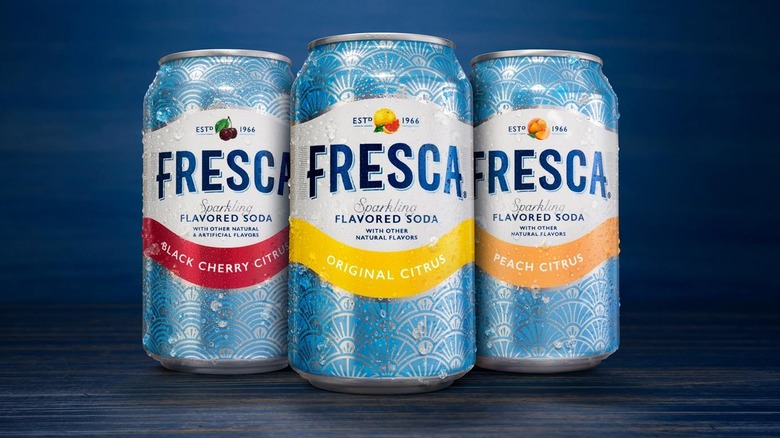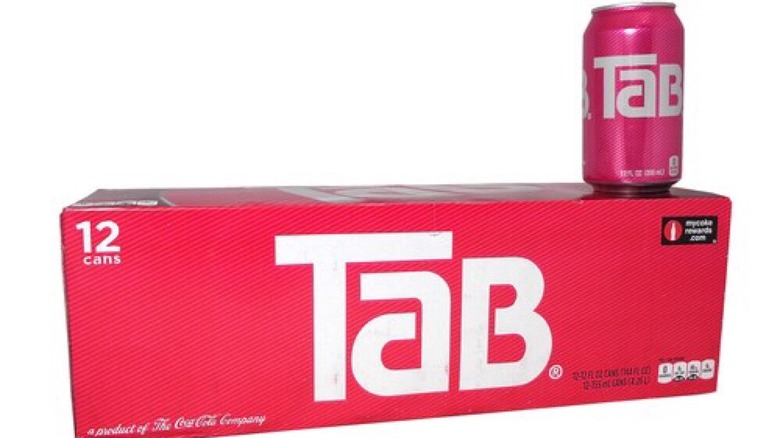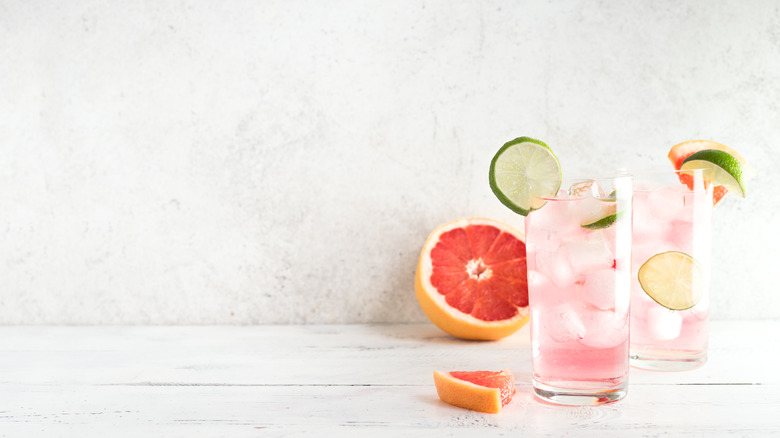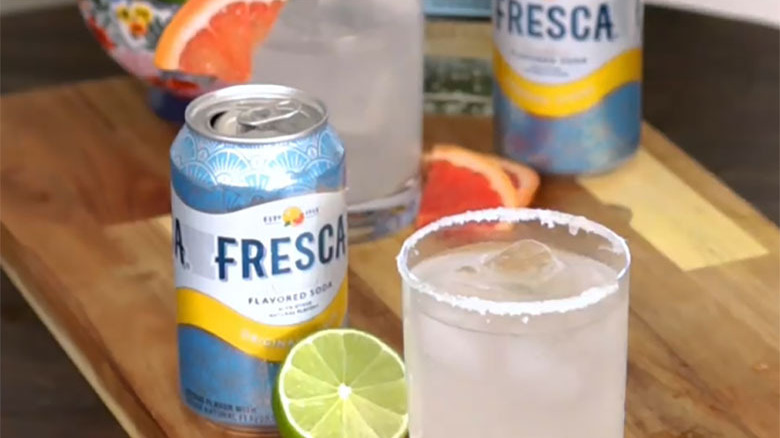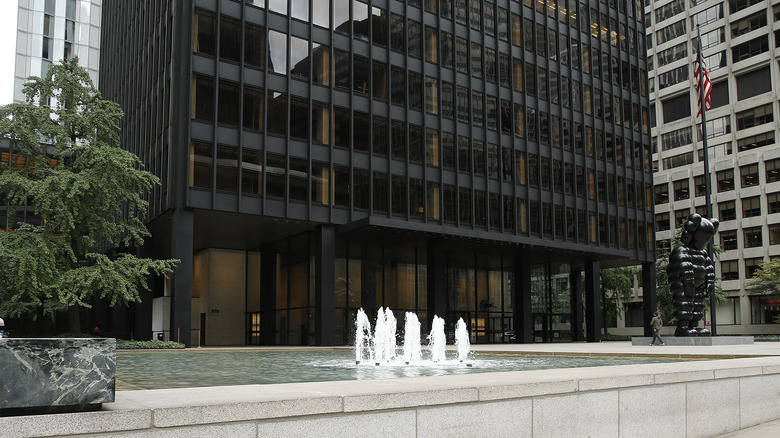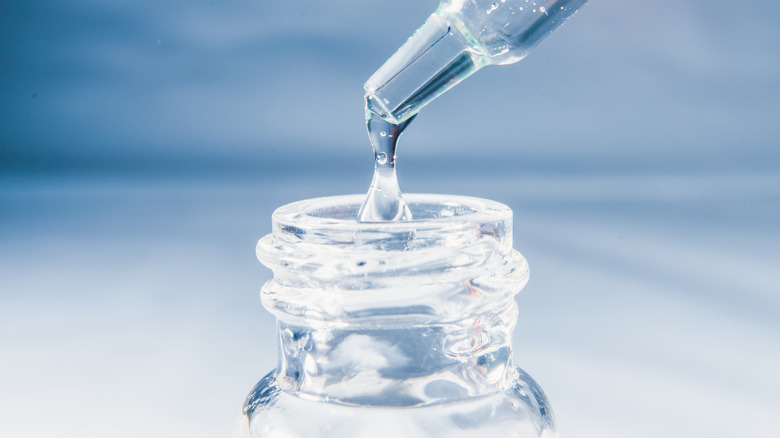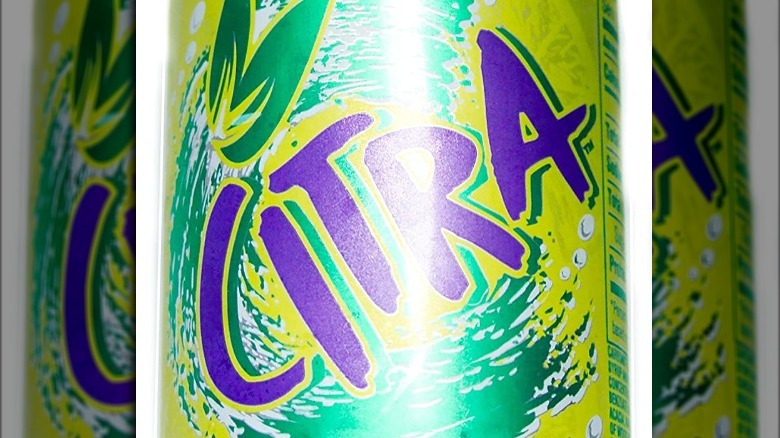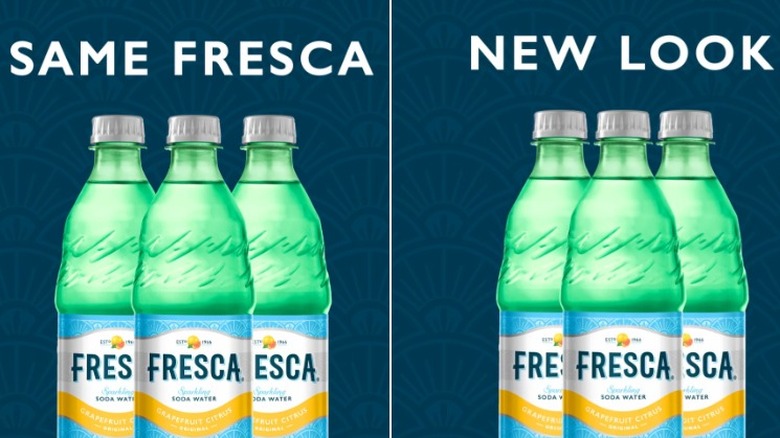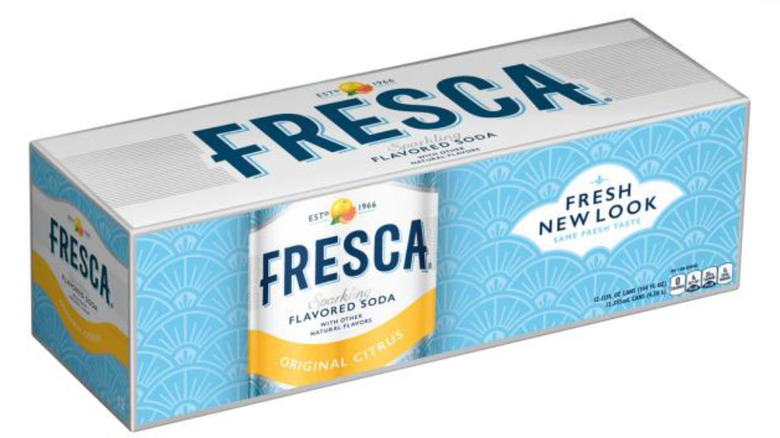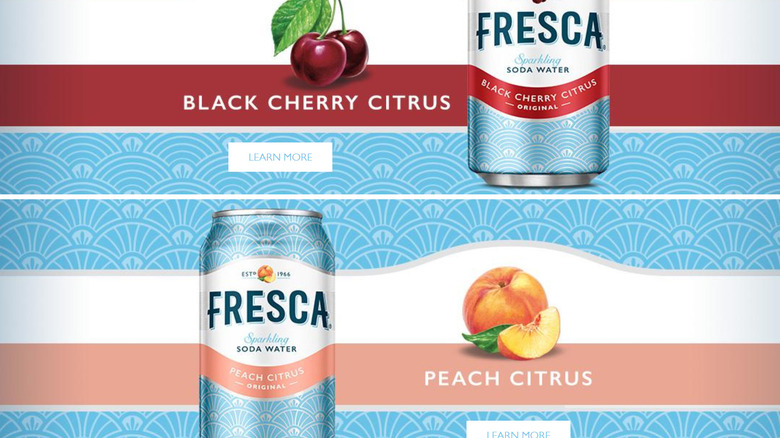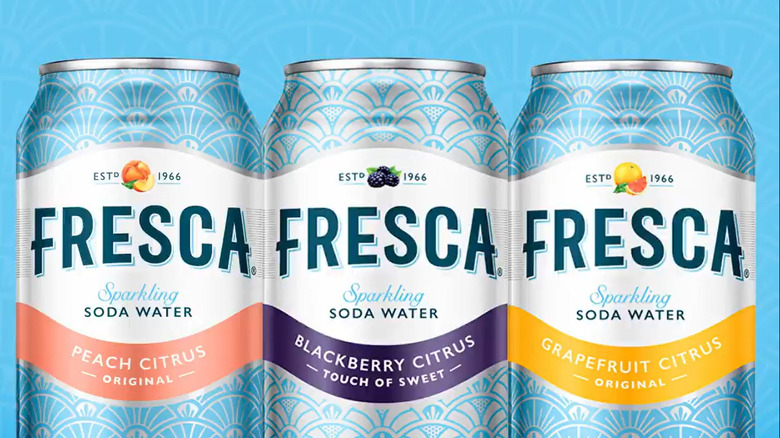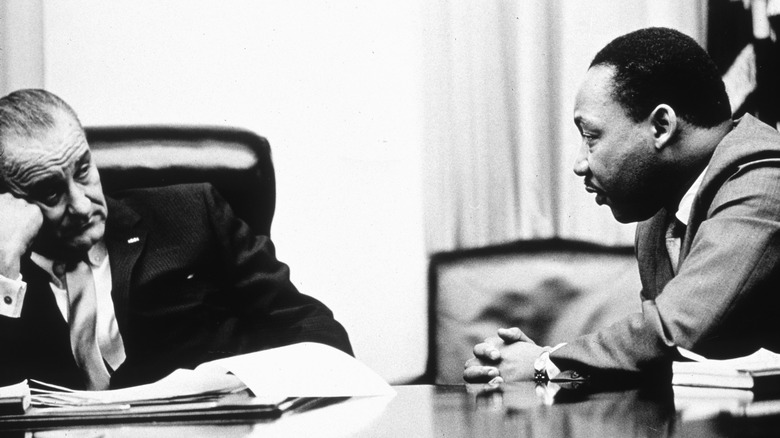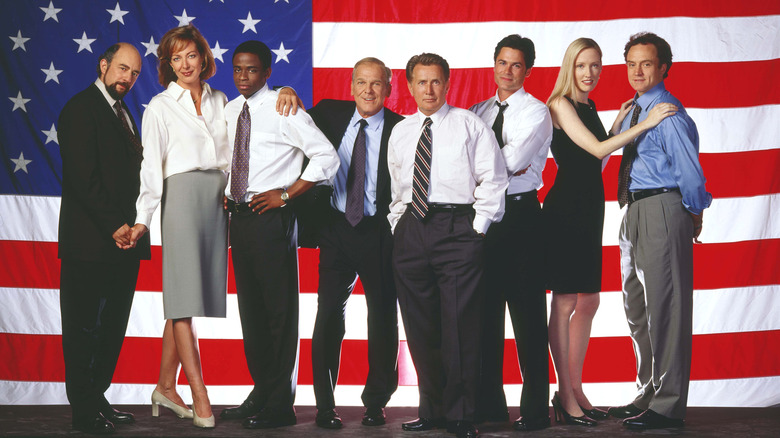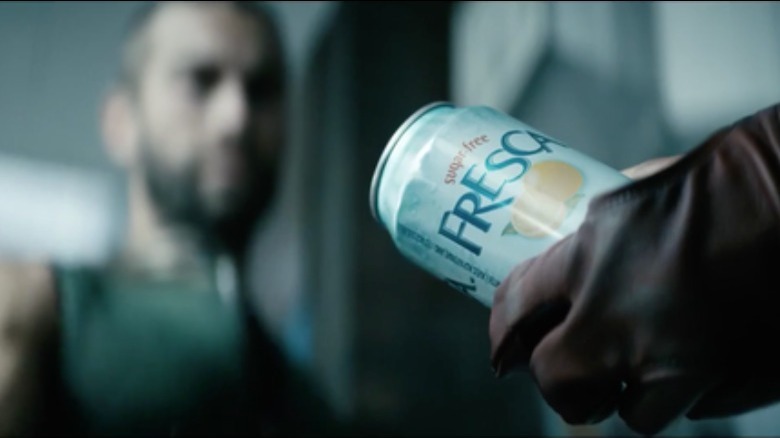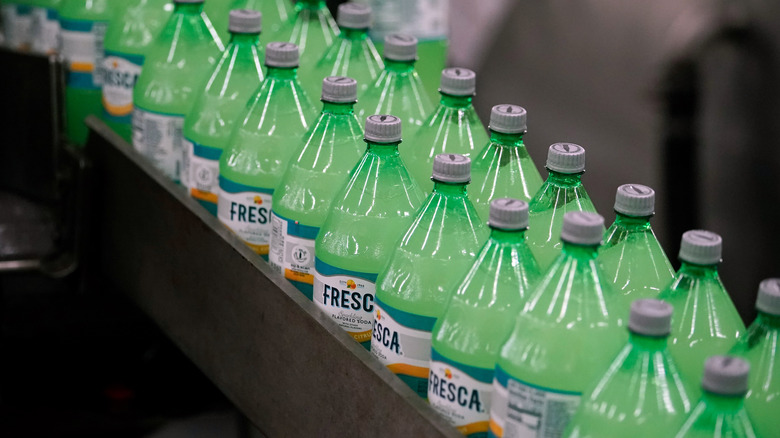The Untold Truth Of Fresca
If you're a fan of Fresca, then you probably understand the tendency to wax poetic about the virtues of this grapefruit/lime-flavored citrus soda whose name is Spanish for "fresh" and whose marketing has likewise included such jingles as "think fresh think Fresca" (via YouTube). Perhaps you even have that tendency, yourself. After all, you do happen to be reading this, and why would you want to know the untold truth of Fresca if you didn't want to have more reasons to love it? As if you needed more reasons. Here's one that only just occurred to us as we were meditating on the loveliness of the recently-trending grapefruit-soda-infused Paloma cocktail: have you ever thought about the fact that Fresca was grapefruit soda way before grapefruit soda became a thing (via Brisan Group)?
You already know Fresca has lots of flavor but zero sugar, carbs, and gluten. You already must appreciate the fact that it's a cloudy soda, as opposed to a clear soda, which kind of makes it look like a snowstorm in a glass (true fact, that, as you shall soon find out). And you probably already appreciate that Fresca won't stain your clothes if you dribble as you drink (not that you do, but still). So, really, what more do you need to know? Lots actually! Please join us for the deepest dive anyone has ever taken into everything Fresca.
Fresca fans have Tab to thank for their bubbly grapefruit-flavored fix
For the fact that Fresca even exists today, Fresca fans have the original on-trend sugar-free slash diet slash low-sugar slash zero-sugar soda to thank: "Tab" (stylized as "TaB" for purposes of its logo, may it rest in power, via Snopes). Fresca was the second artificially sweetened soda launched by The Coca-Cola Company. The first was TaB, which made its debut in 1963 with an eye toward attracting the "beautiful" people (via Wall Street Journal) — or at least the calorie-conscious. Although not everyone loved Tab's literally-saccharin flavor, it was generally so well-received that the idea of following its success up with a sugar-free soda that tasted nothing like cola was an obvious next step. So in 1964, Fresca rolled out to test markets.
"After a series of successful pilots in select cities," writes Coca-Cola on its webpage devoted to the telling of Fresca's origin story, "Fresca was ready for the big time." Fresca launched on February 7, 1967 at a lavish and very-high end party in New York City — the details of which we'll get to in a minute.
Fresca was marketed as both a beverage and a mixer
When Fresca was first introduced in test markets, Coca-Cola decided to take a novel approach to winning over new consumers. In fact, Coca-Cola decided to take Fresca in a completely different direction — by marketing the citrus-flavored beverage not as an alternative to soda at all, except insofar as sparkling water is considered a soda. In other words, Fresca was positioned as an alternative to seltzer, despite that it has an audacious, rather than a subtle, flavor, and is artificially sweetened.
In addition, Coca-Cola made the very wise decision to cover as many bases as possible with their marketing of Fresca. When Fresca first came out, it was marketed as both a beverage that could stand on its own and as a mixer for alcoholic beverages. And it worked. Boy, did it work because after more than 54 years, not even counting the years during which Fresca was in test markets, Fresca is still happily ensconced in Coca-Cola's permanent lineup (well, as permanent as that can be). And Fresca manages to do so without a record of sales that come even close to classic Coke's, according to Deseret News, which pointed out that for 2004, just for comparison's sake, Fresca's sales were at 23.6 million cases, while classic Coke's were 77% higher. Of course, it doesn't hurt that the love for Fresca stands as a unifying characteristic of Generation X (via YouGov).
Fresca has an interesting relationship with winter weather
When Fresca was first introduced by the Coca-Cola company back in 1967, the marketing team was searching for a way help consumers to distinguish, and perceive the added value represented by, Fresca — versus its recently released zero-calorie, cola-flavored older-sibling, Tab. What they ended up coming up with was the idea that Fresca offered a "blizzard" of taste. Now, that might have made a bit more sense if Fresca hadn't been launched in the dead of winter. Or looking at it from a different perspective, perhaps it made perfect sense because if you take a look at a glass of Fresca, you can see that it does kind of, at least abstractly, resemble a well-contained snowstorm. And since Fresca was launching in February, perhaps the marketing team thought that associating Fresca with a winter weather condition was almost like sending a subliminal message (via Business Insider).
As it turned out, the marketing team behind Fresca's launch deserved big-time props because Fresca's big launch party in New York City coincided with one of winter 1967's biggest snowstorms. So, the fact that the "unifying tag line for Fresca centered around a 'blizzard' of taste" proved to be a genius move on the part of Coca-Cola — at least in 20/20 hindsight (via Coca-Cola.
Fresca had a launch party at one of New York City's swankiest spots
When "Fresca was ready for the big time," Coca-Cola writes on its webpage devoted to Fresca's origin story, only one venue seemed to represent the brand's new beverage properly, and that was New York City. More specifically, that meant the then-four-years-old-but-already-renowned restaurant, the Four Seasons, which opened in 1959 in the "architecturally acclaimed Seagram's building" at the super high-end intersection of Park Avenue and 52nd Street in midtown Manhattan. Architecture buffs may know the restaurant's interior space because of its own architectural significance. Designed by famed architects, Ludwig Mies van der Rohe and Philip Johnson, the Four Seasons Restaurant featured an enormous interior water fountain — right smack in the middle of one of its dining rooms — and that wasn't even "the" dining room where people wanted to see and be seen (that would have been the "Grill Room" (via Town & Country).
To entertain guests, Coca-Cola hired 1967's version of an alt-rock star, Mitch Miller, who hated pop music (according to "Jazz Singing" by Will Friedwald (Scribners 1990), via Festive Fanzine) but was nevertheless commissioned to write and record an apropos theme song for the fete. The "Blizzard Theme" is still available on vinyl today (via Amazon). And yes, there was a blizzard that day, but that worked right into Coca-Cola's plans!
The original sugar-free formulation for Fresca has changed over the years
Diet soda is as popular as it is controversial, according to Healthline. One reason for the ongoing controversy is that while diet soda adds no sugar, calories, or carbs to one's diet, it does offer a generous helping of manufactured artificial sweeteners made from various chemicals that can be disconcertingly difficult to pronounce. When Fresca was launched in 1967, it was getting its sweetness from cyclamates, just as its precursor and inspiration, Tab, did. Within a year, however, the Secretary of the U.S. Department of Health, Education, and Welfare, was standing on a podium — holding a can of Tab, no less, and announcing that cyclamates were henceforth banned because their consumption increased the risk of bladder cancer in lab animals (via Wall Street Journal, via I Love Tab, and Fast Company).
After cyclamate was banned, Fresca, like Tab, came to rely on saccharin as its primary sweetener. Starting in 1982, Coca-Cola replaced the saccharin with aspartame, and while Tab drinkers balked (despite the warning labels the FDA now required for products containing saccharin), Fresca drinkers kept right on (via The Conversation). By 1985, Fresca was all in with a reformulation consisting of "one percent real fruit juice...100% sweetened with NutraSweet" (via L.A. Times). Today, the artificial sweetness of Fresca comes from a combination of aspartame and acesulfame potassium (via Fooducate), neither of which has the cleanest reputation among health professionals (via Healthline).
The truth about those rumors of sugar-sweetened Fresca
Just like everything else, Fresca is not above becoming the topic of misinformation and fake news. Here and there over the years, there has been talk of Coca-Cola having come up with a sugar-sweetened Fresca. Some say that sugar-sweetened Fresca was unique to Latin America until 1997 or 1998 (depending on whom you're talking to), which is when Fresca allegedly "responded to requests for this product from immigrant communities" by introducing sugar-sweetened Fresca (via Pipi Wiki).
But here is where the story of sugar-sweetened Fresca goes off-course: the sugar-sweetened soda in question is called "Citra." Coca-Cola, indeed, launched a sugar-sweetened soda called "Citra" in 1998, but Citra was positioned not as a sugar-sweetened alternative to Fresca but as a caffeine-free citrus soda alternative to Mountain Dew — only with less audacious bubbles, according to South Carolina's Herald-Journal, which made sure to clarify that this particular Citra was not to be confused with Coca-Cola's other Citra soda, which it had acquired along with the rest of the assets that once belonged to the Indian company, Parle Bisleri, which is a lemon-lime-flavored soda not marketed by Coca-Cola in the U.S.
In any event, Fresca does not offer a sugar-sweetened version. Fresca is and always has been, strictly speaking, a sugar-free soda.
Fresca is not actually flavored seltzer, although you'd be forgiven for thinking as much
The way that Fresca has sought to characterize itself has evolved quite a bit over the years, with the latest iteration being as a sparkling "soda water" with the flavor of "Grapefruit Citrus." Characterizing Fresca not as a soda, per se, but flavored soda water, represents a subtle but nonetheless significant change from Fresca's penultimate iteration as a sparkling "flavored soda with other natural flavors." The "flavored soda" packaging was introduced in 2018 in a huge effort by Coca-Cola to "plot a comeback of sorts" for Fresca, according to a statement released by Coca-Cola at the time.
"We realized we're sitting on a potential goldmine," said Ryan Hughes, associate brand manager for Sprite and Citrus Brands at Coca-Cola. "Fresca is a magical brand that, when once people taste and experience, fall in love with. It hits the sweet spot somewhere between a soda and a flavored sparkling water." But does it really — hit the sweet spot somewhere between soda and flavored sparkling water? The Fresca fans among us offer a resounding "no." Apparently, other consumers were equally dubious because at some point between then and now Fresca found itself compelled to rebrand itself fully as a flavored "soda water."
But we're not fooled, Fresca. We're not fooled.
Fresca's packaging has been redesigned several times to emphasize sophistication
Apart from the ever-so-slightly misleading wording on its current trade dress, Fresca has undergone a number of extreme makeovers over the years. In most, if not all, cases, each makeover was intended to bring the Fresca brand closer to what the powers that be thought its targeted demographic should be. When Fresca walked the runway, so to speak, at the Four Seasons Restaurant in 1967, its packaging was intended to invoke the "blizzard of flavors" that Coca-Cola marketing gurus had chosen as the soft drink's tag line (via Coca-Cola). The blizzard theme continued to dominate throughout the 1960s, even as Fresca was forced to change its artificial sweetener profile and cop to having two calories despite having no sugar. But by the late 1970s, Fresca had begun to modernize its look. Rather than depicting a blizzard, the packaging merely "whispered" snow with one single, elegant snowflake.
By the early 1980s, with the modern art movement having become fully ensconced in American style (via Washington University in St. Louis), Fresca cans now sported a color-blocked look that resembled a mashup of Rothko and Mondrian. Fast-forwarding to 2005, Coca-Cola decided Fresca could afford to amp up its image as a soft drink for sophisticates and came up with packaging that it felt matched that vibe (via Deseret News). Its latest look, which came in 2018 was specifically designed to appeal to Millennials, according to a Coca-Cola press release.
Many flavor varieties have been introduced over the years
Funny thing about Fresca: although it was created for the express purpose of leveraging the flavor of grapefruit, over the years, Coca-Cola has introduced a number of new flavors that have nothing whatsoever to do with grapefruit, except insofar as the word "citrus" is tacked on to every single flavor's name (e.g., Black Cherry Citrus and Peach Citrus). So, what are all the Fresca flavors? If you go strictly by the Fresca U.S. website, those flavors, which are "enjoyed primarily by 'discerning adults' in countries around the world," are currently Original Citrus, Black Cherry Citrus, Peach Citrus, and Blackberry Citrus (via Fresca).
However, if you go by the "Best Fresca Flavors" compiled by Ranker, you might also be able to find "Lemon Lime Citrus" and "Grapefruit Mint Citrus" in some of those countries around the world, including, Argentina, Japan, Bulgaria, and India.
The not-so-great great Fresca disappearance of 2020
The COVID-19 pandemic disrupted numerous industries and among these was the soda industry (canned beverages, actually). Fresca drinkers were nearly brought to their knees with fears that Coca-Cola had discontinued their favorite fizzy diet grapefruit beverage when it disappeared from store shelves in 2020 (via Chicago Sun-Times). As the Chicago Sun-Times so astutely put it, "the popular diet soda vanished along with toilet paper," and as of July 30, 2020, it had not yet returned to store shelves.
Ah, but if only the Sun-Times had waited just two more weeks, it would have discovered — as it eventually did, that Fresca was not one of the Coca-Cola brands being discontinued in 2020 (which brands were known as "zombies," by the way, via Beverage Daily). Even better, it was back on the store shelves. And it turned out that the reason for the shortage had nothing to do with Fresca, itself, but with the aluminum cans in which it's typically purchased by consumers. "The industry-wide aluminum can shortage is the main issue causing distribution and production delays for Fresca," Coca-Cola's Kate Hartman assured the Sun-Times and Fresca fans everywhere in August 2020.
President Lyndon B. Johnson was a major Fresca fanboy
President Lyndon Baines Johnson may have felt he had a lot to prove in the Oval Office as he took the place of the fallen President John F. Kennedy in 1963. One week after Johnson died in January 1973, boxes and boxes of extensive recordings he had made of conversations he had while acting as President were released to his Presidential Library. But whatever his motivation, the fact remains that thanks to Johnson's diligent record-keeping, it is now public knowledge that our 36th president possessed a serious Fresca jones. So much so that he saw fit to create a system by which he would never be denied his fix.
In a lounge adjacent to the Oval Office that had originally been designed for President Dwight D. Eisenhower to recuperate from one of his heart attacks, but which President Johnson used to hold "relaxed' meetings with people he hoped to influence with his trademark "Johnson treatment," Johnson had a button he could press that would alert his staff to the fact that he was having a craving (for Fresca). Sadly for all later Fresca-loving Presidents of the U.S., the button was removed at the tail end of Johnson's second term.
President Bartlet couldn't get Fresca in Aaron Sorkin's The West Wing
Ah, the perks of being an actual U.S. President versus one who came straight out of the imagination of Aaron Sorkin. Had President Josiah Bartlet of the popular NBC series, "The West Wing" wanted to get his hands on a Fresca — as in "right now," the way President LBJ did, apparently it seems he would have been out of luck because the fictional White House of the NBC series did not stock Fresca. And the series writers made it their business to point out that fact in Season 2, episode 7 of "The West Wing" ("The Portland Trip"), according to IMDb. During that episode, fictional Associate White House Counsel, Ainsely Hayes (played by Emily Procter), who was known for her sweet tooth, her annoyingly fast metabolism, and her penchant for Fresca (notwithstanding said fast metabolism, via The West Wing Fandom) tried unsuccessfully to obtain a can of Fresca while working at the White House.
Alas, Associate Counsel Hayes was informed that they don't keep Fresca in the building.
Fans of Amazon Prime's The Boys have an almost worrisome Fresca obsession
Amazon Prime's hit series, "The Boys," features a strangely compelling sub-sub-plot involving Fresca, and fans of the show spend a remarkable amount of time trying to figure out exactly what it might mean (via Men's Health). That includes a surprising number of Reddit boards devoted to precisely that (via Reddit).
To briefly summarize a three-episode arc, one of the superheroes, The Deep, (played by Chace Crawford), is being recruited into a seemingly evil cult called "The Church of the Collective." Several times over the course of his recruitment, The Deep is offered a Fresca. And it's not incidental; as Men's Health pointed out, the camera focuses on the can tip the viewer off to this.
Men's Health, whose spirit superhero must be Captain Obvious, is going with the theory this is a reference to the Jonestown cult, whose leader, Jim Jones, accomplished the mass suicide of 900 of his followers by offering them cyanide-laced Kool-Aid (actually a Kool-Aid knock-off, but still, this is where the saying "to drink the Kool-Aid" comes from). It was an offer they couldn't refuse, apparently.
Actually, Fresca is a perennial pop culture reference
Speaking of offers that can't be refused, Fresca was, at least once, name-dropped in HBO's "The Sopranos" (via the New York Times). It was also a plot point in the episode of "The Simpsons" entitled "Dude, Where's My Ranch," in which Homer is told he's drinking "bear urine," but it turns out to be Fresca (via IMDb) — although as Fresca fans, we're not amused. Fresca is also featured in the episode of "The Simpsons" entitled "A Fish Called Selma," in which one character, Troy, suggests he loves another as much as he loves Fresca (via IMDb). That seems legit, although one would hope that Troy is planning on honoring, obeying, and drinking Fresca and only Fresca for the rest of his natural life.
Fresca has also appeared in HBO's "Silicon Valley," according to Product Placement, and Tom Selleck name-checked Fresca in a 2017 piece he wrote for the Hollywood Reporter in tribute to his co-star on "Magnum P.I., John Hillerman. "My image of John between shots was sitting in a director's chair with a cigarette in a long cigarette holder, drinking a Fresca. He always had a Fresca, but he did it all so elegantly."
But pop-culture references to Fresca are as old as Fresca, itself. The first known is from a 1967 Trini Lopez recording of "The Blizzard Song," the purchase of which came with a free case of Coca-Cola's brand-new grapefruit-citrusy, sugar-free soda, Fresca (via Peaches and Dreams).
